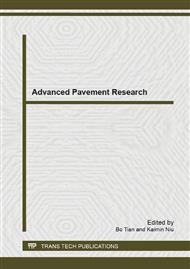[1]
Wimsatt, A. J., and McCullough, B. F. Subbase friction effects on concrete pavements, Proc., 4th Int. Conf. on Concrete Pavement Design and Rehabilitation, Purdue Univ., West Lafayette, Ind, (1989).
Google Scholar
[2]
Robert Otto Rasmussen and Dan K. Rozycki, Characterization and Modeling of Axial Slab-Support Restraint, Transportation Research Record No. 1778, Transportation Research Board, (2001).
DOI: 10.3141/1778-04
Google Scholar
[3]
Chia, W.S., McCullough, B.F., Burns, N.H. Field Evaluation of Subbase Friction Characteristics, Research Report 401-5. Center for Transportation Research, The University of Texas at Austin, September (1986).
Google Scholar
[4]
Seung Woo Lee, Characteristics of Friction between Concrete Slab and Base, Vol. 5, No. 4, (2000).
Google Scholar
[5]
Zhang J. and V.C. Li. Influence of Supporting Base Characteristics on Shrinkage-Induced Stresses in Concrete Pavements. Journal of Transportation Engineering, ASCE, Vol. 127, No. 6, pp.455-462, (2002).
DOI: 10.1061/(asce)0733-947x(2001)127:6(455)
Google Scholar
[6]
Young Chan Suh, S.W. Lee., and M. S. Kang. Evaluation of Subbase Friction for Typical Korean Concrete Pavement. Journal of Transportation Research Board, No. 1809, National Research Council, Washington D.C., (2004).
DOI: 10.3141/1809-08
Google Scholar
[7]
Mendoza-Diaz, Alberto, B. Frank McCullough, and Ned. H. Burns, Behavior of Long Prestressed Pavement Slabs and Design Methodology, Research Report 401-3, Center for Transportation Research, The University of Texas at Austin, November (1986).
Google Scholar
[8]
Wimsatt, Andrew W., McCullough, B. Frank, and Burns, Ned H. Methods of Analyzing and Factors Influencing Frictional Effects of Subbases, Research Report 459-2F, Center for Transportation Research, The University of Texas at Austin, November (1987).
Google Scholar
[9]
Wesevich, J.W., B.F. McCullough, and N.H. Bums, Stabilized Subbase Friction Study for Concrete Pavements, Research Report 459-1, Center for Transportation Research, The University of Texas at Austin, November (1987).
Google Scholar
[10]
Seung Woo Lee, Behavior of Concrete Slab under Frictional Drag, KSCE Journal of Civil Engineering, Vol. 5, No. 2, (2001).
DOI: 10.1007/bf02829070
Google Scholar


